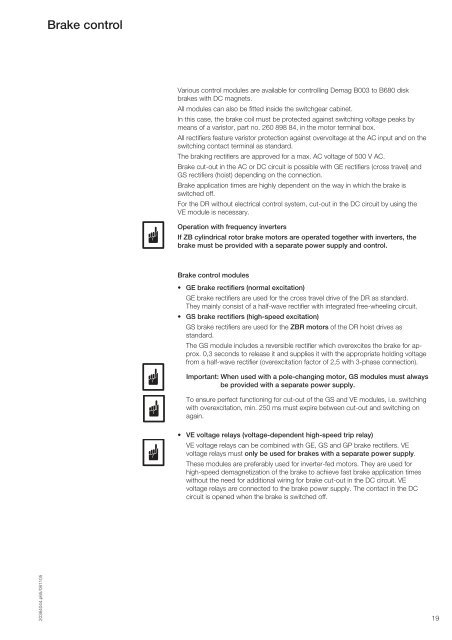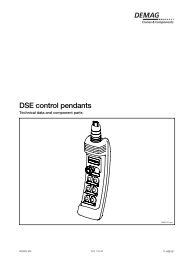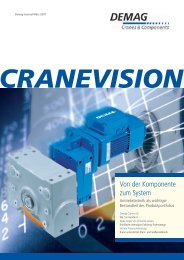Demag DR rope hoist - Demag Cranes & Components
Demag DR rope hoist - Demag Cranes & Components
Demag DR rope hoist - Demag Cranes & Components
You also want an ePaper? Increase the reach of your titles
YUMPU automatically turns print PDFs into web optimized ePapers that Google loves.
20364044.p65/081105<br />
Brake control<br />
Various control modules are available for controlling <strong>Demag</strong> B003 to B680 disk<br />
brakes with DC magnets.<br />
All modules can also be fitted inside the switchgear cabinet.<br />
In this case, the brake coil must be protected against switching voltage peaks by<br />
means of a varistor, part no. 260 898 84, in the motor terminal box.<br />
All rectifiers feature varistor protection against overvoltage at the AC input and on the<br />
switching contact terminal as standard.<br />
The braking rectifiers are approved for a max. AC voltage of 500 V AC.<br />
Brake cut-out in the AC or DC circuit is possible with GE rectifiers (cross travel) and<br />
GS rectifiers (<strong>hoist</strong>) depending on the connection.<br />
Brake application times are highly dependent on the way in which the brake is<br />
switched off.<br />
For the <strong>DR</strong> without electrical control system, cut-out in the DC circuit by using the<br />
VE module is necessary.<br />
Operation with frequency inverters<br />
If ZB cylindrical rotor brake motors are operated together with inverters, the<br />
brake must be provided with a separate power supply and control.<br />
Brake control modules<br />
GE brake rectifiers (normal excitation)<br />
GE brake rectifiers are used for the cross travel drive of the <strong>DR</strong> as standard.<br />
They mainly consist of a half-wave rectifier with integrated free-wheeling circuit.<br />
GS brake rectifiers (high-speed excitation)<br />
GS brake rectifiers are used for the ZBR motors of the <strong>DR</strong> <strong>hoist</strong> drives as<br />
standard.<br />
The GS module includes a reversible rectifier which overexcites the brake for approx.<br />
0,3 seconds to release it and supplies it with the appropriate holding voltage<br />
from a half-wave rectifier (overexcitation factor of 2,5 with 3-phase connection).<br />
Important: When used with a pole-changing motor, GS modules must always<br />
be provided with a separate power supply.<br />
To ensure perfect functioning for cut-out of the GS and VE modules, i.e. switching<br />
with overexcitation, min. 250 ms must expire between cut-out and switching on<br />
again.<br />
VE voltage relays (voltage-dependent high-speed trip relay)<br />
VE voltage relays can be combined with GE, GS and GP brake rectifiers. VE<br />
voltage relays must only be used for brakes with a separate power supply.<br />
These modules are preferably used for inverter-fed motors. They are used for<br />
high-speed demagnetization of the brake to achieve fast brake application times<br />
without the need for additional wiring for brake cut-out in the DC circuit. VE<br />
voltage relays are connected to the brake power supply. The contact in the DC<br />
circuit is opened when the brake is switched off.<br />
19









